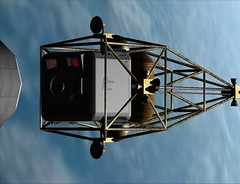
Today's Space Review has the second part of Grant Bonin's article on the case for smaller launch vehicles in human space exploration. He makes a lot of good points, the biggest one being that NASA's plans to spend $10 billion to develop a shuttle-derived heavy lift launch vehicle will have the effect of putting too many eggs in one basket - again. And it won't be available for a long time. Planning to use multiple medium-lift vehicles (some of which are operational already, with more in the pipeline) offers diversity and options, although it requires changes to the major human mission architectures, requiring multiple launches and on-orbit assembly. Critics say that the MLV approach is too complex and has too many risks, but it seems that both approaches have risks and complexity, they are just distributed differently. The MLV approach deserves a closer look in my opinion.
If multiple non-crewed MLV launches are used to get the parts for a Moon or Mars mission into orbit, how will they be assembled there? Rendezvous to the near-vicinity of an orbiting object is pretty routine - Orbiter users do it all the time! Seriously, even in real life, automated rendezvous is not that hard these days (e.g. the Russian Progress resupply vehicles for the ISS). But you would need to have some sort of "space tug" to move the parts around and assemble them without requiring astronaut EVA's to do everything. I don't know where development stands on such a vehicle, but Orbiter has one you can practice with, the Dragonfly. Even though it lacks any sort of robot arm (which I assume would be a practical requirement for many tasks), it has a docking port and can dock with objects that have a docking port (such as the supplied practice space station modules), move them around, and dock them with other modules. The picture shows a closeup of the craft (more on Flickr). This is a short-range space-only vehicle with thrusters only (no main engines). It also has detailed panels and internal spacecraft systems (and its own 22 page PDF manual).
N.B. I decided to look up space tugs in Google, and I find the term applies also to robot (or remotely operated) spacecraft, including one that has been proposed by Orbital Recovery Corp. to boost satellites to higher orbits. Such a tug could possibly be used to save the Hubble Space Telescope without a Shuttle mission, and perhaps they could also be developed for use in some on-orbit assembly jobs.
No comments:
Post a Comment